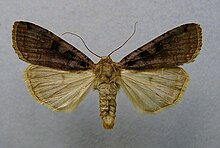Trapeze floor owl
| Trapeze floor owl | ||||||||||||
|---|---|---|---|---|---|---|---|---|---|---|---|---|

Trapeze ground owl ( Xestia ditrapezium ) |
||||||||||||
| Systematics | ||||||||||||
|
||||||||||||
| Scientific name | ||||||||||||
| Xestia ditrapezium | ||||||||||||
| ( Denis & Schiffermüller , 1775) |
The trapezoid-ground owl ( Xestia ditrapezium ), also called Ditrapez-earth-owl , is a butterfly ( moth ) from the family of the owl butterflies (Noctuidae).
features
butterfly
The moths reach a wingspan of 38 to 47 millimeters. The forewings have a comparatively narrow shape and are dark brown, red-brown or purple-brown in color. A small, black spot appears in the root field. Between the ring and kidney flaws and the inner transverse line there are large, further darkened, black spots that are sometimes connected in a C-shape or U-shape. The outer transverse line is thin and doubled. The wavy line ends in a black spot at the costal edge . The hind wings are yellow-gray without drawing and are always much lighter than the forewings.
Caterpillar, pupa
Adult caterpillars have a gray-brown or red-brown basic color, a thin, dark back line and a brownish marbling. A few blackish lines can be seen on the rearmost segments. The doll is characterized by a dark brown color and two long, slightly curved thorns on the cremaster .
Similar species
There is a great similarity to the triangular ground owl ( Xestia triangulum ) as well as to the East Asian species Xestia kollari . While triangulum is lighter brown in color and has wider forewings, kollari usually differs by a darker middle field and darker hind wings. The similar black C ( Xestia c-nigrum ) can be recognized by the white-gray area between the kidney and ring flaws.
Distribution and occurrence
The species occurs in Western and Central Europe, through the temperate zone to East Asia and Tibet . In the Alps it rises to an altitude of around 1,800 meters. The trapezoid ground owl prefers to inhabit forests, bank areas of water bodies, shrub and shrubbery areas as well as park landscapes.
Way of life
The nocturnal moths mainly fly from May to August in one generation per year. You visit artificial light sources and bait , and occasionally the flowers of the dwarf elder ( Sambucus ebulus ). The caterpillars can be found from September. They feed on a variety of plants, including:
- Blueberry ( Vaccinium myrtillus ),
- Raspberry ( Rubus idaeus ),
- Blackthorn ( Prunus spinosa ),
- Birches ( Betula ) and
- Alder trees ( Alnus ).
They overwinter and pupate in a cave in May of the following year.
Danger
The trapezoid ground owl is not rare in Germany and is listed as not endangered on the Red List of Endangered Species .
swell
Individual evidence
- ↑ Michael Fibiger: Noctuinae II . In: WG Tremewan (Ed.): Noctuidae Europaeae . 1st edition. tape 2 . Entomological Press, Sorø 1993, ISBN 87-89430-02-6 (English).
- ↑ a b c Günter Ebert (Ed.): The butterflies of Baden-Württemberg . 1st edition. tape 7 . Moth V Noctuidae 3rd part. Ulmer, Stuttgart (Hohenheim) 1998, ISBN 3-8001-3500-0 .
- ↑ Walter Forster , Theodor A. Wohlfahrt : The butterflies of Central Europe. Volume 4: Owls. (Noctuidae). Franckh'sche Verlagshandlung, Stuttgart 1971, ISBN 3-440-03752-5 .
- ↑ Manfred Koch : We identify butterflies. Volume 3: Owls. 2nd, expanded edition. Neumann, Leipzig / Radebeul 1972, DNB 760072930 .
- ↑ Federal Agency for Nature Conservation (Ed.): Red List of Endangered Animals in Germany . Landwirtschaftsverlag, Münster 1998, ISBN 3-89624-110-9 .
literature
- Michael Fibiger: Noctuinae II . In: WG Tremewan (Ed.): Noctuidae Europaeae . 1st edition. tape 2 . Entomological Press, Sorø 1993, ISBN 87-89430-02-6 (English).
- Günter Ebert (Ed.): The butterflies of Baden-Württemberg . 1st edition. tape 7 . Moth V Noctuidae 3rd part. Ulmer, Stuttgart (Hohenheim) 1998, ISBN 3-8001-3500-0 .
Web links
- Lepiforum eV photos
- www.schmetterlinge-deutschlands.de Endangerment
- Xestia ditrapezium in Fauna Europaea
